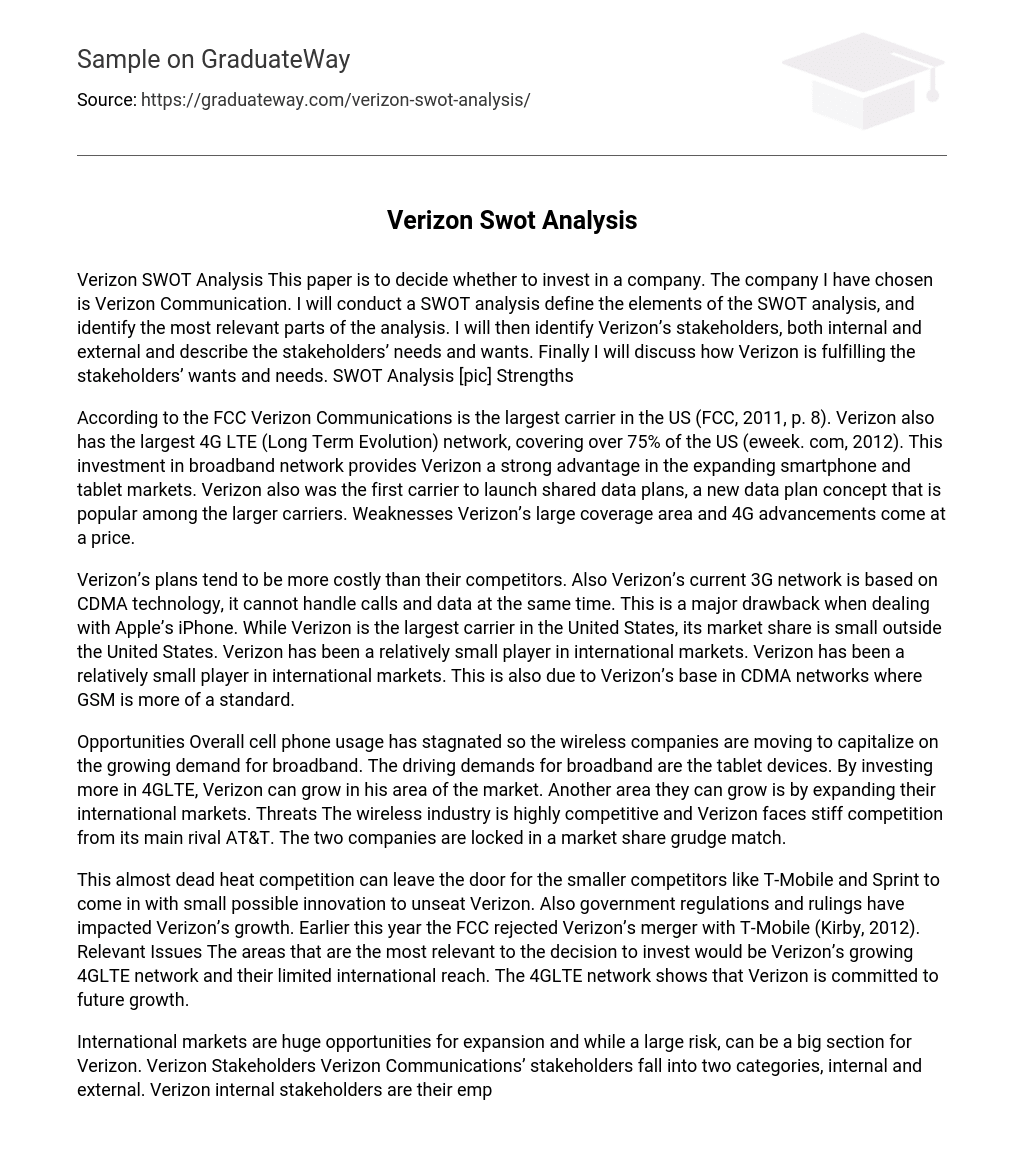Verizon SWOT Analysis This paper is to decide whether to invest in a company. The company I have chosen is Verizon Communication. I will conduct a SWOT analysis define the elements of the SWOT analysis, and identify the most relevant parts of the analysis. I will then identify Verizon’s stakeholders, both internal and external and describe the stakeholders’ needs and wants. Finally I will discuss how Verizon is fulfilling the stakeholders’ wants and needs. SWOT Analysis [pic] Strengths
According to the FCC Verizon Communications is the largest carrier in the US (FCC, 2011, p. 8). Verizon also has the largest 4G LTE (Long Term Evolution) network, covering over 75% of the US (eweek. com, 2012). This investment in broadband network provides Verizon a strong advantage in the expanding smartphone and tablet markets. Verizon also was the first carrier to launch shared data plans, a new data plan concept that is popular among the larger carriers. Weaknesses Verizon’s large coverage area and 4G advancements come at a price.
Verizon’s plans tend to be more costly than their competitors. Also Verizon’s current 3G network is based on CDMA technology, it cannot handle calls and data at the same time. This is a major drawback when dealing with Apple’s iPhone. While Verizon is the largest carrier in the United States, its market share is small outside the United States. Verizon has been a relatively small player in international markets. Verizon has been a relatively small player in international markets. This is also due to Verizon’s base in CDMA networks where GSM is more of a standard.
Opportunities Overall cell phone usage has stagnated so the wireless companies are moving to capitalize on the growing demand for broadband. The driving demands for broadband are the tablet devices. By investing more in 4GLTE, Verizon can grow in his area of the market. Another area they can grow is by expanding their international markets. Threats The wireless industry is highly competitive and Verizon faces stiff competition from its main rival AT&T. The two companies are locked in a market share grudge match.
This almost dead heat competition can leave the door for the smaller competitors like T-Mobile and Sprint to come in with small possible innovation to unseat Verizon. Also government regulations and rulings have impacted Verizon’s growth. Earlier this year the FCC rejected Verizon’s merger with T-Mobile (Kirby, 2012). Relevant Issues The areas that are the most relevant to the decision to invest would be Verizon’s growing 4GLTE network and their limited international reach. The 4GLTE network shows that Verizon is committed to future growth.
International markets are huge opportunities for expansion and while a large risk, can be a big section for Verizon. Verizon Stakeholders Verizon Communications’ stakeholders fall into two categories, internal and external. Verizon internal stakeholders are their employees. Verizon’s external stakeholders are customers and investors. Internal Wants and Needs Verizon’s employees’ wants and needs are a high priority for the company. Verizon asked an independent research firm to poll people from a wide range of Verizon’s organization. The results were very good.
According to Verizon’s website (2012) “About 4 in 10 consider Verizon’s CR programs to be excellent; 8 in 10 consider them to be excellent or good. ” External Wants and Needs Customer satisfaction is always very fickle. One person’s experience can be widely different from another, according to J. D. Power (2011). Verizon won the J. D. Power customer care award. This is a measurably sign that Verizon is focused on the customer. It seems that investor needs are being net as well. Verizon seems to be moving upward. Verizon has been paying dividends at a very stable rate despite the current economic climate.





